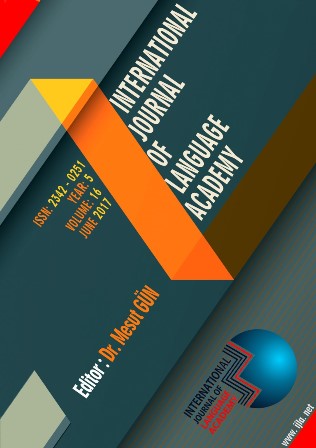Author :
Abstract
Araştırmanın amacı, Aktif Öğrenme Yaklaşımı tekniklerinden Akvaryumun iki dilli öğrencilerin Türkçe konuşma becerilerine olan etkisini belirlemektir. Araştırmada nicel araştırma yöntemlerinden ön test-son test kontrol gruplu deneysel desen kullanılmıştır. Araştırmanın çalışma gruplarını 2015-2016 eğitim-öğretim yılında Van'ın Tuşba ilçesindeki bir devlet orta okulunun 7. sınıfına devam eden ve deney-kontrol gruplarını oluşturan 48 iki dilli öğrenci oluşturmaktadır. Araştırma sonucunda elde edilen verilerin analizinde SPSS 20 paket programı aracılığıyla parametrik testlerden t-testi istatistiği kullanılmıştır. Araştırma sonuçları genel olarak değerlendirildiğinde: Deney ve kontrol grubu öğrencilerinin Türkçe konuşma becerisi ön test verileri arasında istatistiksel olarak anlamlı bir fark bulunmazken son test verilerinde Türkçe konuşma becerisi başarısında Akvaryum tekniğinin uygulandığı deney grubu lehine istatistiksel olarak anlamlı sonuçlar elde edildiği belirlenmiştir. Diğer bir deyişle Akvaryum tekniğiyle yapılan öğretimin, iki dilli 7. sınıf öğrencilerinin Türkçe konuşma becerisi üzerinde, 2006 Türkçe Dersi Öğretim Programı çerçevesinde hazırlanan ders kitapları temelli yapılan etkinliklere nazaran daha başarılı sonuçlar verdiği belirlenmiştir.
Keywords
Abstract
The objective of the study was to determine the effect of the aquarium, an active learning approach, on the Turkish verbal skills of bilingual students. An experimental design with pre-test and post-test control group was used in the study. The study and control groups included 48 bilingual students who attended the seventh grade in a state secondary school in Tuşba county in the province of Van in 2015-2016 academic year. In the analysis of the obtained data in the study, parametric t-test statistic was used via the SPSS 20 software. General assessment of the study findings demonstrated that that there was no statistically significant difference between pretest Turkish verbal skill scores of the students in the experiment and control groups, however a statistically significant difference was observed between the posttest Turkish verbal skill scores of the students in the experiment and control groups, favoring the experimental group where the aquarium technique was applied. In other words, it was determined that instruction with the aquarium technique resulted in higher achievement in Turkish verbal skills of bilingual 7th grade students when compared to the instruction conducted with the activities found in 2006 Turkish Language Course curriculum textbooks.





